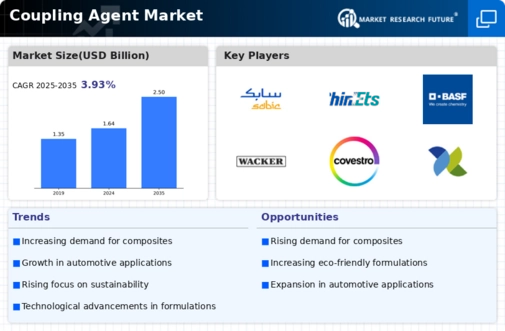Expansion of the Automotive Sector
The expansion of the automotive sector is a significant driver for the Global Coupling Agent Market Industry. As electric vehicles gain traction, the need for lightweight materials that enhance performance and efficiency becomes paramount. Coupling agents are essential in the production of advanced composites used in electric vehicles, contributing to weight reduction and improved energy efficiency. The automotive industry is expected to account for a substantial share of the market, with increasing investments in electric vehicle technology. This growth is anticipated to support the market's expansion, aligning with the projected market size of 1.64 USD Billion in 2024.
Rising Demand for Composite Materials
The Global Coupling Agent Market Industry is experiencing a notable increase in demand for composite materials, driven by their lightweight and high-strength properties. Industries such as automotive and aerospace are increasingly adopting composites to enhance fuel efficiency and performance. For instance, the automotive sector is projected to utilize more than 50% composite materials in vehicle production by 2025. This shift is expected to contribute significantly to the market, with the Global Coupling Agent Market projected to reach 1.64 USD Billion in 2024. Coupling agents play a crucial role in improving the interfacial adhesion between different materials, thereby enhancing the overall performance of composites.
Growing Awareness of Sustainable Practices
The Global Coupling Agent Market Industry is witnessing a shift towards sustainable practices, as industries increasingly focus on reducing their environmental impact. The demand for eco-friendly coupling agents, derived from renewable resources, is on the rise. This trend is particularly evident in the construction and packaging sectors, where companies are seeking sustainable alternatives to traditional materials. The adoption of bio-based coupling agents is expected to grow, reflecting a broader commitment to sustainability. As a result, the market is likely to benefit from this shift, with a projected CAGR of 3.91% from 2025 to 2035, indicating a robust growth trajectory.
Technological Advancements in Polymer Science
Technological advancements in polymer science are propelling the Global Coupling Agent Market Industry forward. Innovations in polymer formulations and processing techniques are enabling the development of more efficient coupling agents that enhance compatibility between polymers and fillers. For example, the introduction of silane-based coupling agents has shown to improve the mechanical properties of polymer composites significantly. As these technologies evolve, they are likely to drive market growth, with projections indicating a market size of 2.5 USD Billion by 2035. The continuous research and development efforts in this area suggest a promising future for coupling agents in various applications.
Increased Investment in Infrastructure Development
Increased investment in infrastructure development is another key driver for the Global Coupling Agent Market Industry. Governments worldwide are allocating substantial budgets for infrastructure projects, including roads, bridges, and buildings. This surge in construction activity necessitates the use of advanced materials, where coupling agents play a vital role in enhancing the properties of construction materials. The demand for high-performance concrete and other composite materials is expected to rise, thereby driving the coupling agent market. As infrastructure projects continue to expand, the market is likely to see sustained growth, contributing to the overall market dynamics.


















Leave a Comment